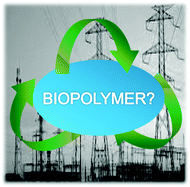Is it possible to develop biopolymer production systems independent of fossil fuels? Case study in energy profiling of polyhydroxybutyrate-valerate (PHBV)†
Abstract
A life cycle assessment (LCA) approach was used to explore fossil energy profiles of current and future scenarios for the production of the biopolymer polyhydroxybutyrate-valerate (PHBV). The study was based on primary data collected from industry sources and laboratory research, focused on evaluating the long-term quantitative and qualitative depletion of fossil fuel resources associated with the production of PHBV. The results show that corn farming and corn-glucose production were the dominant contributors to fossil fuel depletion (expressed in MJ surplus energy) over the life cycle of PHBV produced under the current production scale. However, PHBV is presently undergoing substantial development in comparison with the well-developed petrochemical alternatives. The results of forward-looking scenarios under an expanded production scale indicate that the use of renewable resources for process energy requirements for PHBV and glucose production coupled with improved C-utilization efficiency have the potential to reduce fossil fuel depletion by over 50% compared with its current production scale. The use of appropriate lignocellulosic feedstocks and processing technology for glucose production offers potential for further improvement. These results with PHBV support the view that it will be possible with future developments to move to biopolymer production systems that are largely independent of fossil fuels.


 Please wait while we load your content...
Please wait while we load your content...